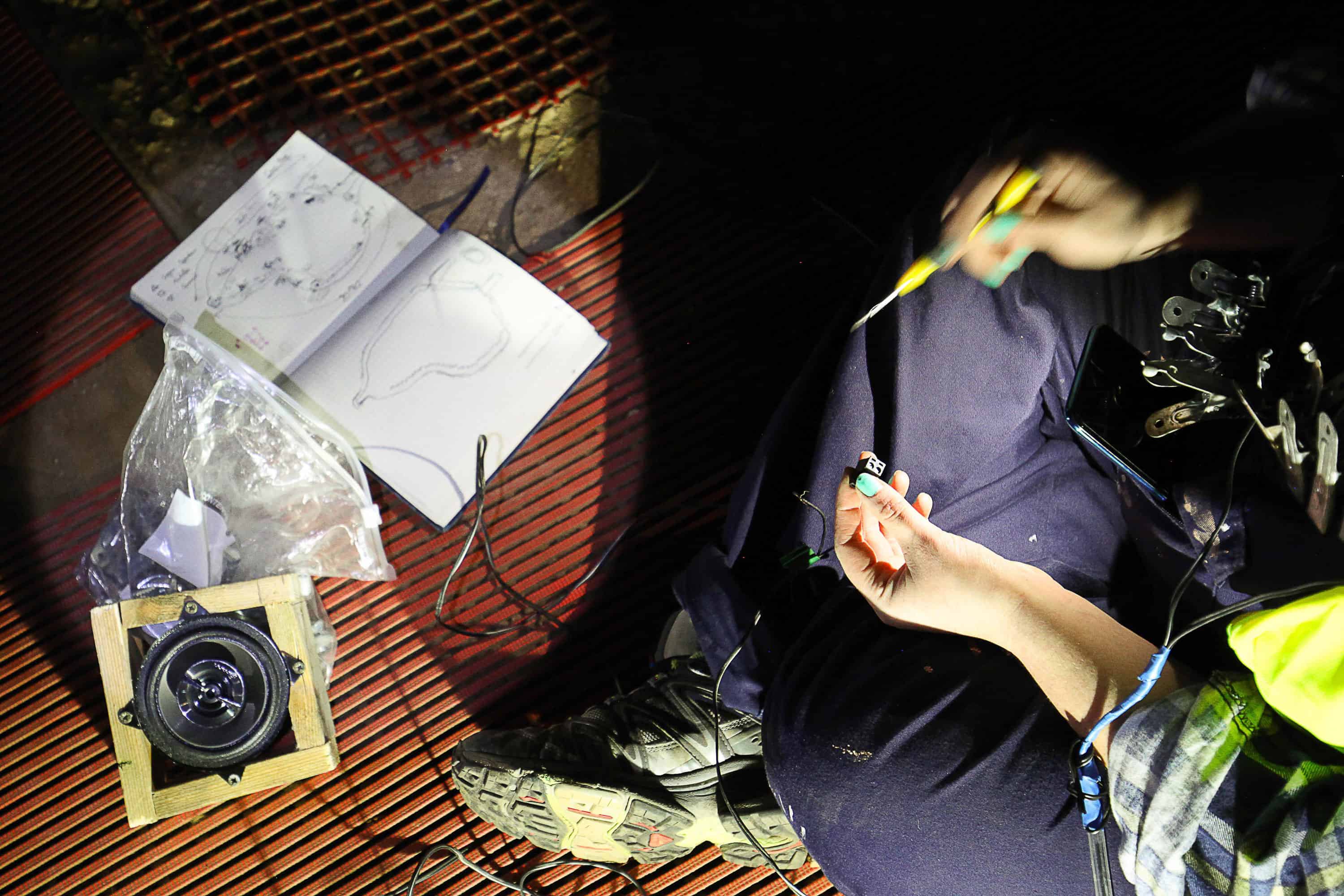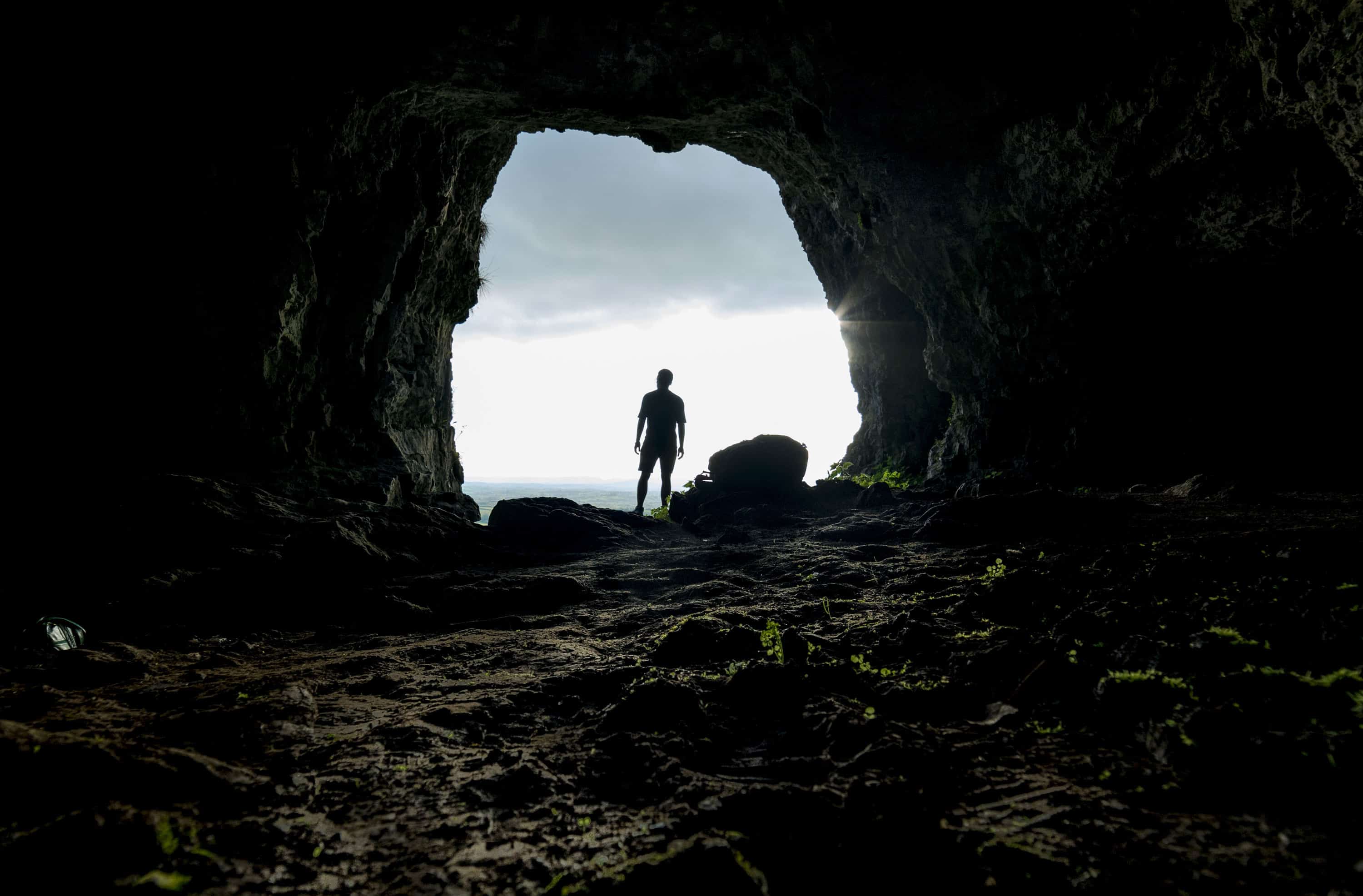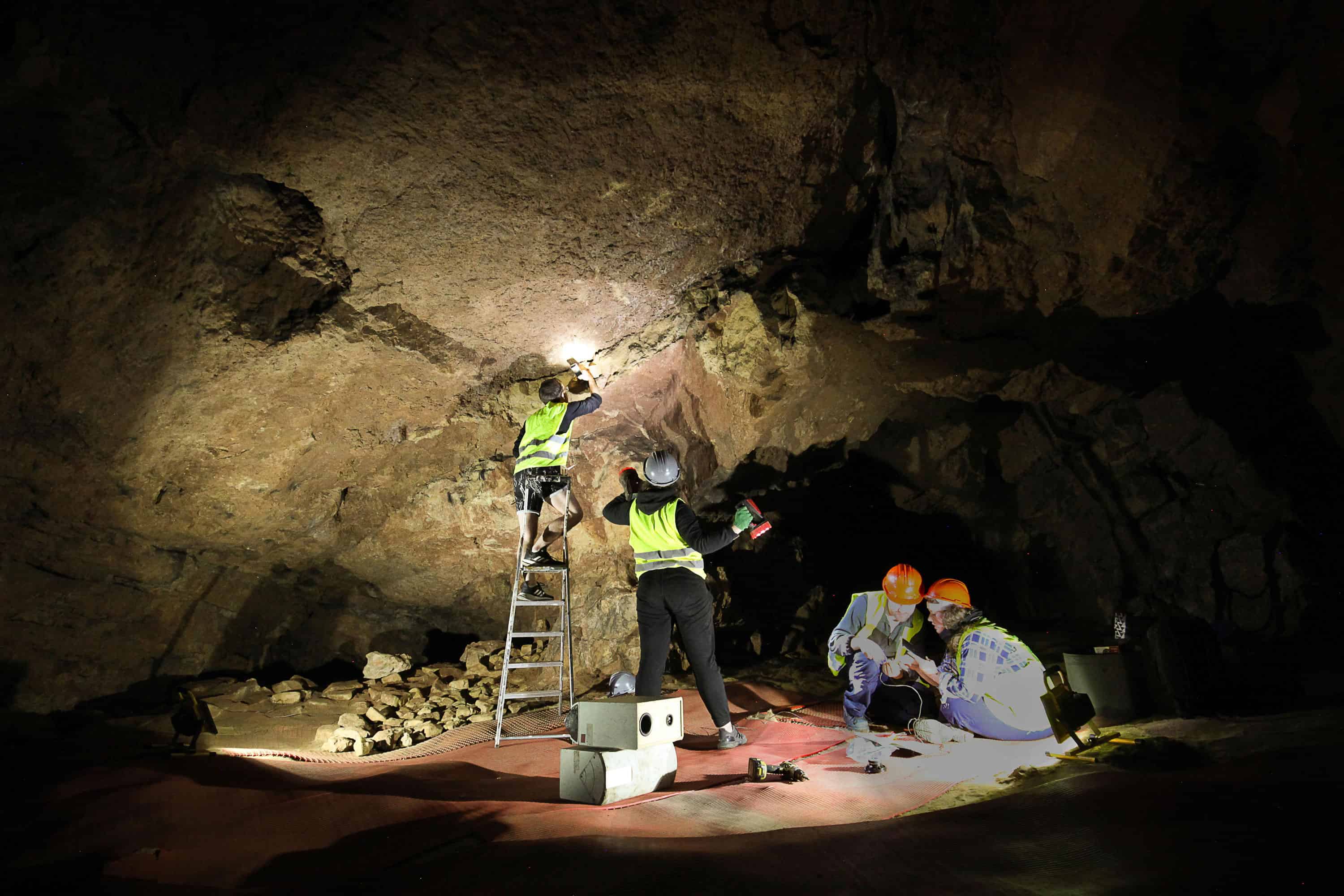AlanJames Burns is an environmental and audiovisual artist. Since 2016, he has developed critically acclaimed multi-sensorial installations in caves of Ireland and Britain, which explored the concept of aural consciousness and mental health. The focal point of his practice remains the human mind, specifically the non-linear ever-fleeing system of divergent thoughts it creates, however his works recently have begun to engage with the problem of climate change. From September 3rd, Burns’s site-specific work, Entirely hollow aside from the dark has inhabited Creswell Crags caves on the border of Nottinghamshire and Derbyshire, UK, which shelter the northernmost examples of Ice Age Rock Art in Europe.
Dominika Tylcz: What exactly is Entirely hollow aside from the dark? I find it difficult to grasp because of its multi-sensorial, multi-dimensional nature.
AlanJames Burns: Entirely hollow aside from the dark is an immersive psychoacoustic sound event taking place inside caves, ancient natural auditoriums carved into the underbelly of the earth’s crust. It is a visceral experience of journeying into Mother Earth’s inner dialogue by using advanced three-dimensional audio system. It engages cutting edge technologies with the most pressing challenges of our time: climate change and mental wellbeing.
Using the cave as a physical metaphor for the mind, the cavern personifies the consciousness of Mother Earth as she struggles with her worsening mental health, brought on by the human distressing of her body. Your engagement with the work begins when you book a ticket and arrive on site at the Creswell Crags Museum & Heritage Centre in late evening. It is here that you are given the bespoke induction to the experience, safety instructions and and a small torch to help guide you on your journey to the caves. As you are walking into the mouth of the cave, the cave is breathing. Once everyone gets settled, we journey deeper into the body of Mother Earth together, sounds of lungs, heart beats and blood passes through the cave until we hear the voice. In total darkness, the audible inner dialogue echoing Mother Earth’s thoughts, unfolding regrets and a symphony of choreographed sounds shifts around the cave, mirroring processes of the human mind. The audience leave to the sound of the cave breathing, just as they entered.
ALANJAMES BURNS / ENTIRELY HOLLOW ASIDE FROM THE DARK / IRELAND from Little Wolf Media on Vimeo.
D.T.: This bridge you make between mental health and environmental awareness is quite unique. In Entirely hollow aside from the dark, the wellbeing and environmental awareness function as complementary elements of the same whole. What inspired you to combine those two threads?
AJB: This version of this site-specific artwork is the third one in the series and has been specifically created for Creswell Crags. Previously, I worked with wellbeing and mental health but the character in the cave was never explicitly Mother Earth. It was always relevant to Mother Earth and environment though. At some point it became natural for me to start introducing the character, to unfold, as Mother Earth.
There are two big issues the world faces: first, the climate crisis and then mental wellbeing. For me, they both go together, they rely on each other to be healthy. Firstly, to have a good mental health and to nurture certain aspects of wellbeing you need a healthy environment, not just the one you live in but the wider ecosystem at large. There is an important aspect of wellness called biophilia, which claims that humans need connection with natural environment and other forms of life. In Entirely hollow aside form the dark, the natural and calming environment of the cave reduces sound and light pollution, creating an opportunity to demonstrate different states of mind, encouraging biophilia and sleep aspect of wellbeing. So we have this kind of innate condition that benefits from being in the natural environment, which is one of major aspects of wellbeing.
To develop the work I worked with music psychology researcher Claire Howlin and we looked at aspects of wellbeing and mental health that could parallel the process of climate change. I asked myself: what can I say about climate change in the form that parallels the mental health problem? What can I say about it if Earth was a human and how would our activity affect its mental health? We looked up the build-up of plastic in the world and we compared it to the tensions built up by plaques in the brain. Plaques are natural things that built up in the cerebral tissue but if you don’t get enough sleep they can build up, they create mental health effects. We thought a lot about that and saw that the effect of accumulation is both true for climate change and for mental health. As we paralleled it with the environmental crisis and the problem of plastic, we realised that if Mother Earth was a person, she would undergo similar stress, but in mental health terms. So we tried to focus on those two processes and bring them together. In order to maintain healthy mental state, you have to follow the natural rhythm: getting enough sleep, getting enough light in the daytime and darkness in the nighttime, but if you’re not getting enough of that, your mental health will start deteriorating. That is why in this project I put Mother Earth to sleep, because she is getting too much light, not darkness, not enough rest time. Hence the title of the artwork, Entirely hollow aside from the dark.
Installation of Entirely hollow aside from the dark by AlanJames Burns, Creswell Crags Caves, September 2019, Photo Marek Wolynski
Entirely hollow aside from the dark, Smugglers Cave, Co Dublin, Photo by Brian Cregan
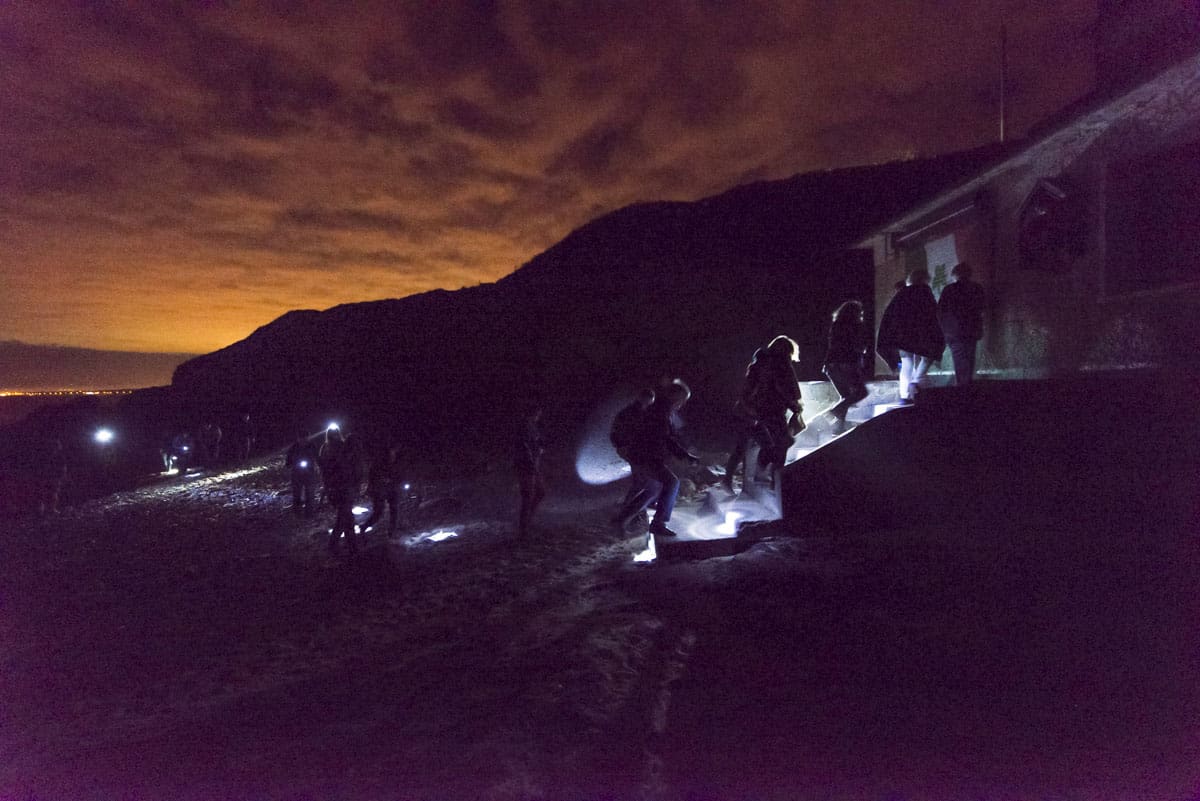
Eniterly hollow aside from the dark, Portrane event, courtesy: Brian Cregan
D.T.: Is this the reason why the experience takes place inside caves?
AJB: It all started one day while taking part in Resort Revelations Residency in North Dublin with Fingal Arts. I was walking the coastline of the small seaside town of Portrane, where there is an abandoned mental health facility and I was thinking about, well, the act of thinking! The tide was out and so I stumbled across Smugglers’ Cave and that moment is what sparked the initial idea of mapping consciousness to the inside of a cave. When we are ‘inside our heads’, do we speak in monologue or dialogue? Do our thoughts emerge in a linear process or are they sporadic? Do we humans ever stop thinking? As a visual artist, I think about these questions through making, research and collaboration. Sitting in the Smugglers’ Cave that day and thinking all this through the idea for the artwork began to form.
D.T.: But how do you approach the vast symbolic potential of caves? Especially in this version of the artwork, where it takes place in Creswell Crags, the only place in the UK to have examples of Ice Age Rock Art from some 13,000 years ago?
AJB: Historically, caves have played a vital role in the simultaneous evolution of creativity and abstract thought. This has been a conceptual underpinning to the artworks development. Caves are the starting point of creativity and abstract art – the Blombos Cave in South Africa has the oldest documented expression of creativity which is a cross hatching marking. It is the oldest known documentation of abstract thought. We don’t know why someone done this all we know is they did this in an abstract manner. In developing this aspect of the work, I conducted extensive research in South Africa and explored a number of caves and early cave art there.
That played really well with the themes developed in the artwork and it is also why I chose Creswell Crags and their cave system which has the only pieces of Ice Age Rock Art on the Western Isles. Creswell Crags have also recently made a significant cultural discovery of hundreds of Witch Marks. These are thought to be the biggest concentration of apotropaic marks, or symbols to ward off evil or misfortune, ever found in the UK. It definitely is very important to the project and it all pieces together to make sense of the artwork.

Eniterly hollow aside from the dark, photo: Alan James Burns
D.T.: And I’m curious what were the main challenges when creating the character of Mother Earth? Weren’t you afraid to anthropomorphize of such a primordial being?
AJB: It has been a bit of a challenge! In previous iterations of the artwork I was always conscious that the cave was some form of Mother Earth, but it was never explicitly her. I’ve developed it over the duration of previous projects. I’ve always been conscious of her gender. In order to this achieve a female mother character, I worked with Sue Rainsford, a writer who is one of the most amazing ones I have ever had the pleasure of knowing. She has done an amazing job with the script. We decided that Mother Earth is weakening, she is going through a mental health breakdown. I tried to put myself in her shoes and discovered ‘Actually, you’re weak, you’re tired, you’re trying to work with humans you’ve nurtured but they are not working with you.’ And we thought that even though she gave us the ability to develop consciousness, she now regrets it, because the humankind uses the conscious experience to damage her.
D.T.: Do you feel like empathy is a good strategy? Can this troubled figure of Mother Earth raise awareness about environmental crisis more efficiently than media or scientific reports?
AJB: Humans are very complex beings and as an artist my best tool is storytelling. I want to tell the story in a way it resonates within the most diverse and the widest range of people. Doing that is one way to create this message and try to bring about a change. It’s the only way I know. I don’t think it is a case of one working more efficiently than the other, but a case of different attempts working together. After all it’s the scientific evidence that resonated with me.
I believe that immersive artworks and experiential means of communication are one of the most effective techniques to create a connection between the subject matter and audience members. Experiential techniques directly engage participants inviting and encouraging them to actively involve in the story. Entirely hollow aside from the dark is an intense artwork and people who have experienced it do feel emotionally connected to the environmental and mental health issues it is centred around.
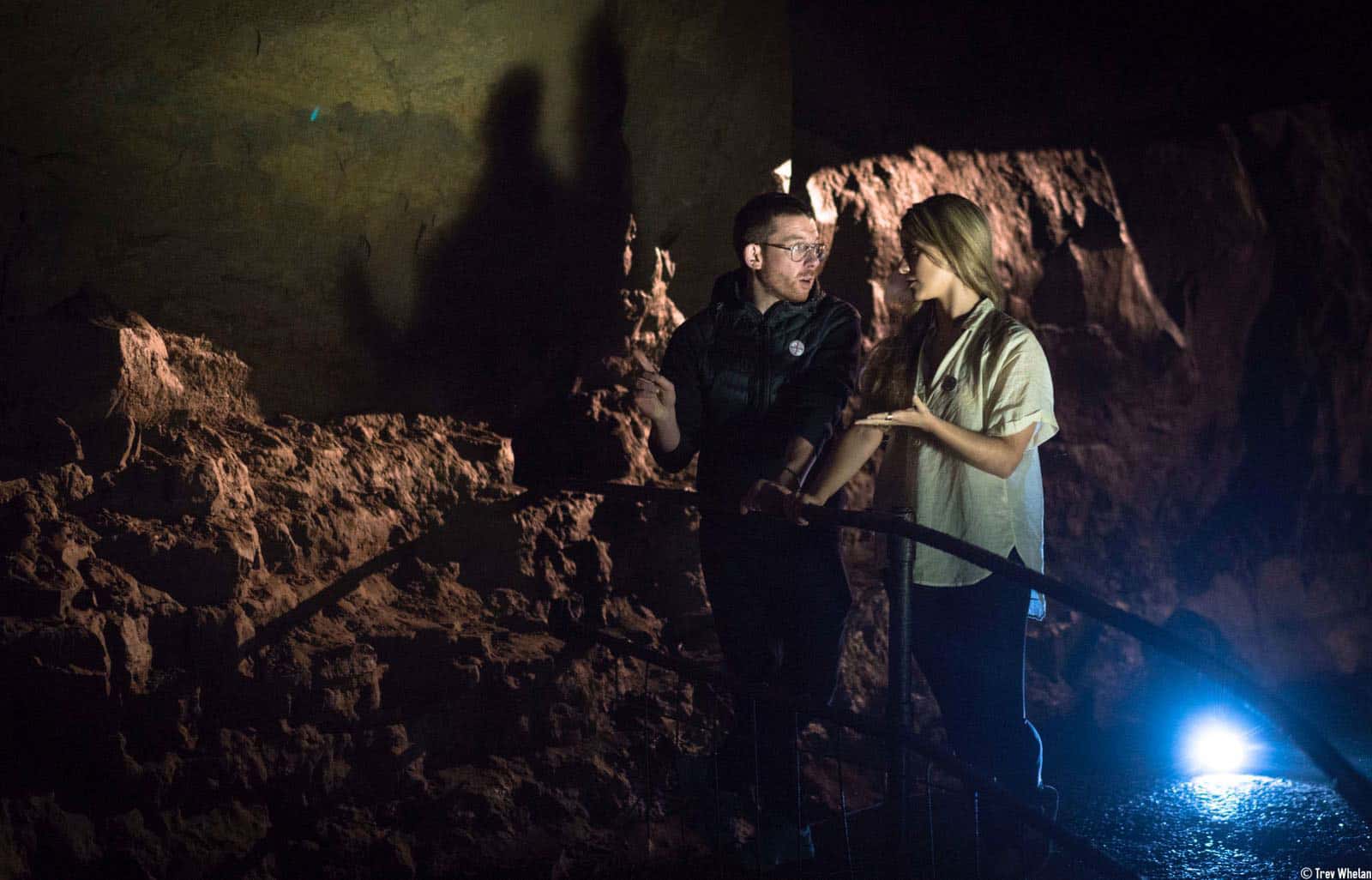
AlanJames Burns and wrtier Sue Rainsford discussing the work In Aillwee Caves ©Trevor Whelan
D.T.: Could you tell me a bit about the technical process of setting up your installation? I imagine it must be particularly tricky to make environmentally conscious art when you make a technological intervention in the living landscape. How difficult it is to make the whole artwork as little impactful as possible?
AJB: The artwork leaves as few traces as possible and in the physical environment of the cave we actually managed to leave no trace at all. In the climate environment, however, we can’t avoid leaving some trace within the society we live in right now. What we have done is we have implemented a questioning system where every aspect of the production needs to be questioned for its sustainability and environmental impact. All the time, we were asking ourselves how can we deliver the same job in the most sustainable manner. While working on the project for Creswell Crags, my team and I successfully discarded flying, we travelled by train and boat. The entire team for the duration of the project adopted a plant-based diet. In developing this project I have worked with sound engineers and electricians to devise a low voltage audio system, which has a low impact on the environment. It does take energy obviously, but it aims not to. We tried to calculate the carbon footprint of every item we use and chose the most sustainable option, but at times it became extremely complex, as in the choice between batteries and rechargeable batteries, where you have to take into account the entire lifecycle of the item, its potential recycling and toxicity of its dumping, and in the end of the day it may be impossible to determine which option is safer for the environment.
I continuously examine my modes of production and the kinds of materials I use, seeking more sustainable solutions every step of the way. I embed climate action into my way of working with businesses, partners and suppliers. Engaging with them about their packaging or methods of production and transit, suggesting different ways they could become more sustainable. I let them know I am always looking for alternative options with more sustainable product solutions. In addition, in my own daily life, I am a vegan and I live as near a plastic-free lifestyle as I can. For us, humans, to remain in healthy mental state involves creating and producing but we have to challenge the way produce and the materials we use to express ourselves. We need to learn how to do that in an environmentally friendly and sustainable manner.

Alan James Burn cave hunting Fermanagh, courtesy: Alan James Burn
D.T.: Are you working on any other project at the moment?
AJB: My next project is called Silicon Synapse, an immersive virtual reality and psychoacoustic sound experience that simulates a journey into the personified, conscious mind of ‘Technology’. Silicon Synapse will be installed within the repurposed historic setting of the Carnegie Library, Swords. This library was once a place of knowledge and learning, shaping the minds and synapses of thousands. The audience will now enter through the remnant doors of the library and into the imagined mind of the silicon technology that has largely replaced it. This sensory artwork is experienced alone, one person at a time. You will hear the inner dialogue of ‘Technology’s’ mind as it ruminates both sides of a lovers’ quarrel. ‘Technology’ and its life partner ‘Nature’ argue about the sustainability of their relationship and their future as a couple. This transhuman, dream-like conscious realm engulfs the participants as they travel through intense listening and visual experiences.
Entirely hollow aside from the dark, Creswell Crags Museum and Heritage Centre, 3 – 7 September 2019 – more
AlanJames Burns and his team installing Entirely hollow aside from the dark inside Creswell Crags Caves, September 2019, Photo Marek Wolynski
AlanJames Burns and his team installing Entirely hollow aside from the dark inside Creswell Crags Caves, September 2019, Photo Marek Wolynski
Eniterly hollow aside from the dark, Installation at Kesh Caves, Sligo








